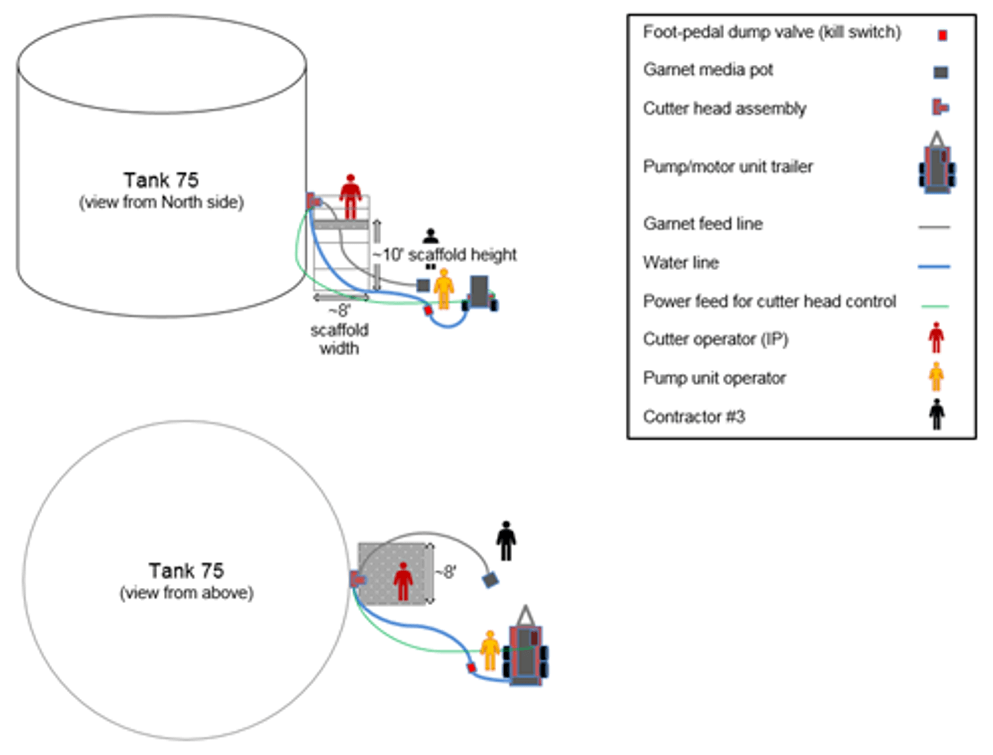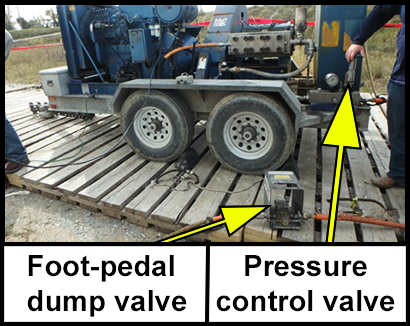-
What happened?
A hydro-cutter operator was preparing to water-cut a hole into a tank at a height of 15 feet/4.5m.
The operator stood less than 6 feet/1.8m behind the cutting assembly to observe and control the depth and direction of the cut.
When the water cutter was turned on, a magnetic holder on the cutter assembly disengaged from the tank wall and the water jet gun spun away.
The high pressure stream lacerated the right leg of the operator.
The operator needed surgery and further treatment.

-
Why did it happen?
The cutter tool came loose from the tank wall and continued to release high pressure water.
The operator closest to the work did not have control over the equipment energy or access to a safety cut-off switch – this was controlled at the bottom of the
scaffold by another operator via the foot pedal dump valve and pressure control valve.
Standard operating procedure did not require personal protective equipment shielding that would prevent laceration at 36,000 pounds per square inch of pressure.

-
What did they learn?
The person closest to the work should have access to a safety cut-off switch or direct control over the equipment.
Adequate personal protection equipment/shielding should be used for operations involving high-pressure water jets.

-
Ask yourself or your crew
What other actions could have been taken?
How can something like this happen here?
How can we ensure the right person has control over the equipment?
Do we use PPE or shielding? How do we know it is adequate for the pressures being used?
What hazards have we missed in the task risk assessment?

Add to homescreen
Content name
Select existing category:
Content name
New collection
Edit collection
What happened?
A hydro-cutter operator was preparing to water-cut a hole into a tank at a height of 15 feet/4.5m.
The operator stood less than 6 feet/1.8m behind the cutting assembly to observe and control the depth and direction of the cut.
When the water cutter was turned on, a magnetic holder on the cutter assembly disengaged from the tank wall and the water jet gun spun away.
The high pressure stream lacerated the right leg of the operator.
The operator needed surgery and further treatment.

Why did it happen?
The cutter tool came loose from the tank wall and continued to release high pressure water.
The operator closest to the work did not have control over the equipment energy or access to a safety cut-off switch – this was controlled at the bottom of the
scaffold by another operator via the foot pedal dump valve and pressure control valve.
Standard operating procedure did not require personal protective equipment shielding that would prevent laceration at 36,000 pounds per square inch of pressure.

What did they learn?
The person closest to the work should have access to a safety cut-off switch or direct control over the equipment.
Adequate personal protection equipment/shielding should be used for operations involving high-pressure water jets.
Ask yourself or your crew
What other actions could have been taken?
How can something like this happen here?
How can we ensure the right person has control over the equipment?
Do we use PPE or shielding? How do we know it is adequate for the pressures being used?
What hazards have we missed in the task risk assessment?
A worker received a laceration as a result of high pressure stream release while water-cutting a hole into a tank. He needed surgery and further treatment.














